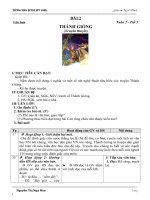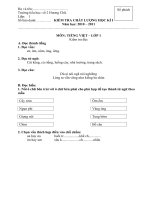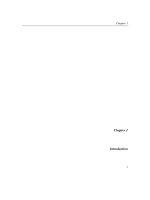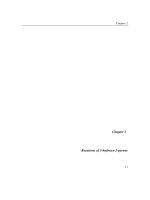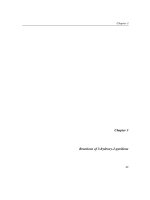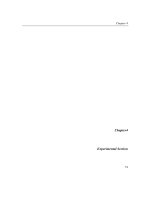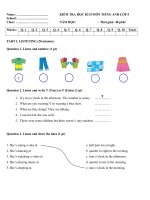2 anaesthesia OSCE n
Bạn đang xem bản rút gọn của tài liệu. Xem và tải ngay bản đầy đủ của tài liệu tại đây (3.17 MB, 187 trang )
Page i
The Anaesthesia OSCE
Page ii
© 1997 Greenwich Medical Media 507 The Linen Hall 162168 Regent Street London W1R 5TB
ISBN 1 900151 60X
First Published 1997
Apart from any fair dealing for the purposes of research or private study, or criticism or review, as permitted under the UK Copyright Designs and Patents Act, 1988,
this publication may not be reproduced, stored, or transmitted, in any form or by any means, without the prior permission in writing of the publishers, or in the case of
reprographic reproduction only in accordance with the terms of the licences issued by the Copyright Licensing Agency in the UK, or in accordance with the terms of
the licences issued by the appropriate Reproduction Rights Organization outside the UK. Enquiries concerning reproduction outside the terms stated here should be
sent to the publishers at the London address printed above.
The publisher makes no representation, express or implied, with regard to the accuracy of the information contained in this book and cannot accept any legal
responsibility or liability for any errors or omissions that may be made.
A catalogue record for this book is available from the British Library
Distributed worldwide by Oxford University Press
Designed and Produced by Derek Virtue, DataNet
Printed in Great Britain by Ashford Colour Press
Page iii
The Anaesthesia OSCE
K Eggers FRCA
J Everatt FRCA
Senior Registrars
Welsh School of Anaesthesia
Maelor Hospital, Wrexham
G Arthurs FRCA
Consultant Anaesthetist
Maelor Hospital, Wrexham
Illustrations by
T Bailey RGN RMN Cert Ed
Maelor Hospital, Wrexham
Page v
Contents
Introduction
1
Data Interpretation
ix
Introduction
1
Data 1
1
Data 2
2
Data 3
3
Data 4
4
Data 5
6
Data 6
7
Data 7
8
Answers
Data Interpretation
2
History Taking
1117
Introduction
19
History 1
21
Follow on Station 1
22
History 2
23
Follow on Station 2
24
History 3
25
Follow on Station 3
26
History 4
27
Follow on Station 4
28
History 5
29
Follow on Station 5
30
Answers
History Taking
3
Skill
3145
Skill 1
47
Skill 2
48
Skill 3
50
Skill 4
52
Page vi
Skill 5
53
Skill 6
54
Skill 7
55
Skill 8
56
Skill 9
58
Answers
Skill 19
4
Physical Examination
5967
Physical Examination 1
69
Physical Examination 2
70
Physical Examination 3
71
Physical Examination 4
72
Physical Examination 5
73
Self Test Physical Examination 5
74
Physical Examination 6
75
Self Test Physical Examination 6
Answers
76
Physical Examinations 16
5
Communication
7789
Introduction
91
Case 1
93
Case 2
94
Case 3
96
Case 4
97
Case 5
98
Case 6
99
Case 7
100
Answers
Cases 17
6
Resuscitation
Resuscitation 1
111
Resuscitation 2
112
Resuscitation 3
113
Resuscitation 4
114
Resuscitation 5
115
Resuscitation 6
116
Answers
Resuscitation 16
101110
117122
Page vii
7
Apparatus
Apparatus 1
123
Apparatus 2
124
Apparatus 3
126
Apparatus 4
128
Apparatus 5
130
Apparatus 6
132
Apparatus 7
134
Apparatus 8
136
Apparatus 9
139
Apparatus 10
Answers
140
Apparatus 110
143153
8
ECG
ECG 1
154
ECG 2
156
ECG 3
158
ECG 4
160
Answers
ECG 14
9
XRays
XRay 1
168
XRay 2
170
XRay 3
172
XRay 4
174
XRay 5
176
XRay 6
178
Answers
XRays 16
163166
180185
Page ix
Introduction
The objective structured clinical examination (OSCE) is a good way of examining a candidate's abilities over a range of skills and reduces examiner bias. The OSCE
can assess skills that have not previously been tested, such as the ability to communicate with, or give advice to patients.
The purpose of this book is to help candidates practise for the OSCE and at the same time encourage the development of skills such as communication and history
taking that are essential to a good clinician. An anaesthetist is a doctor first and then an anaesthetist. A knowledge of both the way to effectively communicate with
patients and good history taking is as important as being able to site an epidural catheter or a tracheal tube.
When you enter the examination premises there is a cloak room for hanging coats but you will need to carry your identification card, wallet and a stethoscope with
you, so wear clothes with pockets or carry a bag. Think about wearing clothes that will allow you to kneel on the floor in the resuscitation station.
The OSCE is made up of a number of quite separate stations. The guidance in: "The Royal College of Anaesthetists Examinations Regulations" should be read for
more details. The regulations indicate that there will be 16 stations lasting approximately 2 hours. Each station is of 5 minutes duration with a 90 second break between
stations. There are at least two rest stations which are also of 5 minutes each with a 90 second preliminary break making a total of six and a half minutes rest. Drinking
water is provided at the rest station as candidates may become quite dry and thirsty with talking for this period of time. In the 90 second break you will sit in a small
booth. There will be a notice with the title of the next station and a short introduction. Read these notes carefully and consider how you will approach this station. Each
station is marked to give a score for that station. This mark is quite separate from all the other stations. It is necessary to gain a pass mark in most of the stations in
order to pass the whole examination. The marks from one station are not added to those in another station. All stations carry equal marks. Some stations may be
marked with a point subtracted for a wrong answer, as in the MCQ examination. Check carefully at each examination for which, if any, of the stations have negative
marking. If there is no negative marking guess, if there is negative marking be more careful.
At the beginning of the examination each candidate is briefed and then directed to a particular booth which is the waiting place before their first station. When every
one is in their correct place a bell or whistle sounds and you move to the station. However
Page x
hyperadrenergic you feel read carefully the instructions for the first station you are about to enter. Some candidates will be in the booth before the rest station and will
start the examination with a rest. Equally some will finish at a rest station. Be prepare to start anywhere in the circuit. Use each rest booth to clear your mind of the
previous station and do not let one poor performance spoil the next station. The role of the examiner varies between stations. At some an examiner will be observing
your performance, at others the examiner will ask you questions and at others you will be left to fill in an answer sheet with minimum examiner contact.
We would emphasis that we feel that one way to failure is not to practise. Stations which involve talking to, or examining a patient particularly require practise if only to
perform the task in five minutes. Have a system or order and apply it methodically so as not to miss out anything. Do not fail to ask simple questions like: "Why are
you in hospital?", "What are you worried about and why?". "Do you smoke or drink"?". For history taking and communication ask a friend to act the part. You may
not like the idea of role play but you will meet it in the examination so find a fellow candidate and use each other. We have drawn computer generated figures, chest x
rays and apparatus diagrams for better black and white reproduction. The actual OSCE will have actual apparatus, proper chest xrays and ECGs but with
identification removed.
The type of stations that may be examined are:
Resuscitation
To demonstrate how to resuscitate a collapsed adult or child. The recommendations of the Resuscitation Council should be followed exactly.
Communication Skills
The skills required here are to listen carefully to the patient and identify the problem(s). Then a number of approaches may be relevant: to give a comprehensive
explanation of the problem, to explain a procedure, to reassure a patient about their anxieties, to obtain consent or to talk about a medical problem. While some time
must be spent listening to ensure that you are on the correct topic it is also important to give accurate and adequate explanations. There may be two of these stations.
History Taking
Take a comprehensive and relevant history from the patient.
Relevant in this context means: identifying the main and secondary condition(s) from which the patient is suffering; the reason for surgery and the fitness of the patient
for that surgery; possible anaesthetic or perioperative problems.
There may be two of these stations.
Page xi
The Follow on Station
This follows after the history taking station. It concerns the examinations and investigations that might be relevant to aid the diagnosis of the patient that you have just
interviewed at the history taking station. Also included are general questions about the condition, drug therapy or management of the patient perioperatively.
Apparatus
The apparatus may need testing or setting up. There may be pictures with questions based on an MCQ pattern. Practise checking all anaesthetic equipment including
the anaesthetic machine. We have presented the reader with a number of apparatus quizzes.
Skill Station
This usually involves a piece of apparatus and the ability to perform a skill such as cricothyroid puncture or the use of an epidural catheter.
Data Interpretation
There will probably be a set of results and 10 questions on those results at each station. There will be a number of these stations, each one on a different aspect of
clinical information, i.e. there will not be two of the same item. There might be tests of knowledge about CXR, ECG, plasma haematology, electrolytes, arterial gases,
pulmonary and cardiac function and anything else that can be investigated relevant to the clinical situation. Check for negative marking. If there is no negative marking
then try all the questions.
Clinical Examination
This involves demonstrating how you will examine part of a patient. This might be one system, e.g. the respiratory system; part of a system, e.g. certain cranial or
peripheral nerves; or one particular physiological measurement, e.g. the blood pressure with some questions relevant to blood pressure.
Page 1
1—
Data Interpretation
Introduction
Each station involving data interpretation is laid out with an artefact or set of results. The artefact may be an ECG or CXR and the set of results from such tests as:
haematology, biochemistry, lung function and cardiac catheter studies. First study the essential information that is given. There will be an answer sheet on which you
mark your answers, similar to an MCQ sheet but with more questions. All questions will be answerable as Yes/No or True/False.
Data 1
(Answers on page 11)
A patient presents with the following haematological results (normal values in brackets):
Haemoglobin 10 g/dl
(11.516.5)
PCV 0.3
(0.40.55)
RBC 3 x 1012/1
(4.56.0)
Reticulocytes 0.3% of RBC
(02%)
Platelets 90 x 109/1
(150400)
WBC 5.6 x 109/1
(411)
Questions
1. –
The red cells might show anisocytosis.
True
False
2. –
The patient has a MCV of 100 fl
True
False
3. –
The patient has a MCH of 28 pg.
True
False
4. –
This anaemia is seen in pregnant patients.
True
False
5. –
The serum B12 and folate should be measured.
True
False
6. –
The patient might complain of a sore tongue.
True
False
7. –
The administration of nitrous oxide for 6 hours causes
changes to cells in the bone marrow.
True
False
8. –
Ferrous sulphate could be given to treat this patient.
True
False
9. –
If the patient is blood group AB they could safely
receive a transfusion of SAGM blood group A.
True
False
Blood transfusion reduces the incidence of rejection of
some organs.
True
False
10. –
Page 2
Data 2
(Answers on page 12)
A 67 year old patient has had several episodes of paroxysmal nocturnal dyspnoea. The cardiac catheter studies show the following pressures (mmHg):
Phasic
Right atrium
–
Right ventricle
Pulmonary artery
–
60/30
40
–
Left atrium
40/20
Left ventricle
120/0
LVEDP
Aorta
12
60/5
Pulmonary artery wedge
Mean
0
120/60
27
–
Questions
1. –
The right atrial pressure is normal.
True
False
2. –
The pulmonary valve is stenosed.
True
False
3. –
Pulmonary oedema is likely to be present.
True
False
4. –
There will be a diastolic murmur.
True
False
5. –
There is likely to be a systolic murmur.
True
False
6. –
The mitral valve normally has an area of 7 cm2.
True
False
7. –
The patient has aortic valve disease.
True
False
8. –
This condition is most commonly seen in females with a
history of rheumatic fever.
True
False
Echocardiography can be used to assess left ventricular
hypertrophy.
True
False
In this patient the difference in pressure between the left
ventricle and left atrium is proportional to the degree of
disease.
True
False
9. –
10. –
Page 3
Data 3
(Answers on page 13)
A 75 years old lady receiving an oral hypoglycaemic and diet to control her diabetes is admitted following 24 hours of nausea and vomiting with abdominal pain
suggestive of appendicitis. Normal values are given in brackets.
Sodium 140 mmol/l
(136149)
Potassium 5 mmol/l
(3.85.2)
Bicarbonate 8 mmol/l
(2430)
Chloride 98 mmol/l
(100107)
PaO2 13 kPa on air
(1215)
PaCO2 2.4 kPa
(4.56.1)
pH 7.1
(7.4)
Glucose 30 mmol/l
(3.05.3)
Urea 15 mmol/l
(2.56.6)
Questions
1. –
The patient has a respiratory acidosis.
True
False
2. –
There is an anion gap of 39 mmol/l.
True
False
3. –
The normal anion gap is less than 18 mmol/l.
True
False
4. –
The patient's condition is compatible with a nonketotic
hyperosmolar state.
True
False
5. –
The ECG will show small P waves.
True
False
6. –
A urine osmolarity of 200 mosmol/l is only found with
prerenal failure.
True
False
7. –
Initial treatment should include calcium.
True
False
8. –
Glucose and insulin would be a safe combination to
administer to this patient.
True
False
Dehydration alone could account for this urea
concentration.
True
False
The calculated serum osmolarity is 355 mosmol/l.
True
False
9. –
10. –
Page 4
Data 4
(Answers on page 14)
A 62 year old man complains of breathlessness. Lung function tests show:
FVC 2.4 l (predicted 2.4 to 3.6)
FEV1 1.4 l
RV 2.8 l (predicted 1.6 to 2.3)
FRC 3.4 l (predicted 2.2 to 3.3)
TLC 5.9 l (predicted 3.9 to 5.6)
TLCO 4.5 mmol/min/kPa (predicted 5.8 to 8.7)
KCO 0.8 mmol/min/kPa/l
The vitalograph and siprometer trace are shown opposite.
Questions
1. –
breath.
True
False
The results are compatible with obstructive lung
disease.
True
False
3. –
The TLC can be measured using a vitalograph.
True
False
4. –
The tests are compatible with emphysema.
True
False
5. –
Steroids might benefit this patient.
True
False
6. –
Propranolol may improve this lung function.
True
False
7. –
This picture can be caused by ankylosing spondylitis.
True
False
8. –
The ECG may show tall P waves.
True
False
9. –
The vitalograph trace represents the figures in the data.
True
False
The spirometer trace is correctly labelled.
True
False
2. –
10. –
FEV1 is the volume of gas breathed out in a normal
Page 5
Vitalograph
Spirometer trace
Page 6
Data 5
(Answers on page 15)
A patient is breathless before routine surgery. Pulse and blood pressure are normal. Arterial blood gases show (normal values are given in brackets):
pH 7.55
PaO2 8 kPa breathing air.
Aterial blood saturation 90%
PaCO2 3.5 kPa
Bicarbonate 20 mmol/l
(2430)
BEB 4
(0)
Hb 15 g/dl
(11.516.5)
Questions
1. –
The patient will be centrally cyanosed at rest.
True
False
2. –
The patient will benefit from oxygen by face mask.
True
False
3. –
The results are suggestive of a metabolic keto
acidosis.
True
False
4. –
This is an acute situation.
True
False
5. –
A possible diagnosis would be pulmonary emboli.
True
False
6. –
The patient will benefit from doxapram therapy.
True
False
7. –
If the patient is a cigarette smoker the pulse oximeter
will underread the oxygen saturation.
True
False
Correcting the alkalosis will lower the oxygen saturation
at the same PaO2.
True
False
The arterial oxygen content is about 18 ml/100 ml.
True
False
The patient should be limited to low concentrations of
inspired oxygen.
True
False
8. –
9. –
10. –
Page 7
Data 6
(Answers on page 16)
The following results are from a preoperative patient (normal values are given in brackets).
Bilirubin 186 µmol/l
(318)
Aspartate transaminase 120 i.u./l
(530)
Albumin 35 g/l
(3550)
Calcium (total) 2.14 mmol/l
(2.252.6)
Alkaline phosphatase 600 i.u./l
(17100)
Urine Positive for conjugated bilirubin.
Gammaglutamyl transpeptidase 25 i.u./l (1055)
Questions
1. –
The patient would appear clinically jaundiced.
True
False
2. –
These findings are typical of alcoholic liver disease.
True
False
3. –
These findings could be due to gall stones.
True
False
4. –
These findings are typical of a patient with hepatitis A.
True
False
5. –
The absence of pain suggests the presence of a
carcinoma.
True
False
In a preoperative coagulation screen the partial
thromboplastin time (PTT) would be a sensitive
measurement of the degree of liver impairment.
True
False
The serum albumin will indicate whether there is
chronically impaired liver function.
True
False
Correction of any coagulopathy in this patient should be
with cryoprecipitate.
True
False
10 mg of vitamin K should be administered daily until 3
days after the operation.
True
False
The prevention of perioperative renal failure in such a
patient should include the administration of mannitol or
frusemide.
False
6. –
7. –
8. –
9. –
10. –
True
Page 8
Data 7
(Answers on page 17)
Pulmonary catheter pressures.
Questions
The right ventricular pressure is abnormal.
True
False
Pulmonary oedema can be present with a normal
pulmonary wedge pressure.
True
False
The average value for oxygen delivery to the tissues in a
healthy adult at rest is 1500 ml/min.
True
False
The average oxygen consumption for an adult at rest is
250 ml/min.
True
False
Increasing the FiO2 from 20% to 100% in a healthy
person will increase the delivery of oxygen by 25%.
True
False
True
False
Label the site of the pulmonary artery flotation catheter at
each position A to D on the diagram opposite.
2. –
3. –
4. –
5. –
6. –
7. –
1. –
Systemic vascular resistance can be calculated by using the
equation:
(mean arterial pressure – central venous
pressure) x 80 divided by cardiac output.
or
(MAP CVP) x 80 / CO.
8. –
The systemic vascular resistance is reduced by sepsis.
True
False
9. –
Pulmonary vascular resistance is reduced by hypoxia.
True
False
10. –
Pulmonary vascular resistance is high in cor pulmonale.
True
False
Page 9
Page 11
Answers
Data Interpretation
Answers — Data 1
Answers — Data 1
1.
True — Anisocytosis is a variation in red cell size often seen with anaemia.
2.
True — The MCV (mean corpuscular volume) is PCV/RBC (in this case 0.3/3). Under 76 fl
(fl = femto or 1015) — microcytic cells, over 95 fl — macrocytic cells.
3.
False — MCH is Hb/RBC, here 10/3 = 33 pg (normal 27 to 32 pg, p = picogram pico = 10
12).
4.
True — Macrocytosis may be due to
•
deficiency of folate e.g. diet, pregnancy, cell breakdown as in leukaemia,
drugs like anticonvulsants;
•
B12
deficiency
e.g.
pernicious
anaemia and
lack of
intrinsic
factor,
following
gastrectomy,
blind loop
syndrome,
ileal disease,
tape worm;
•
Other
reasons e.g.
liver disease
and
alcoholism,
myxoedema
and following
heamorrhage
associated
with a raised
reticulocyte
count.
5.
True — The patient has a macrocytic anaemia — MCV 100 fl.
6.
True — Patients with pernicious anaemia have sore tongues, dyspepsia, neurological
disorders, liver enlargement and retinal haemorrhages and may have gastric
carcinoma. There is an association with certain autoimmune conditions like
myasthenia gravis and thyrotoxicosis.
7.
True — Nitrous oxide exposure causes inhibition of methionine synthetase activity which will
lead in time to megaloblastic changes.
8.
False — This is not an iron deficiency anaemia.
9.
True — AB is a rare group (3% population), with A and B antigen on the red cells but no
serum antibodies. Group A is common (45% population) with A antigen on the red
cells and antibodies to B in the serum. These antibodies are washed away in the
formation of SAGM blood.
10. True — The incidence of kidney rejection is reduced. The recurrence of some cancer cells
may be increased.
Page 12
Answers — Data 2
Answers — Data 2
1.
False — Normal 07mmHg.
2.
False — No pressure gradient from the right ventricle to the pulmonary artery.
3.
True — A wedge pressure above 15mmHg may be associated with pulmonary
oedema.
4.
True — There is mitral stenosis. The PAWP is about the same as the left atrial pressure
and at the end of diastole PAWP is higher than LV diastolic pressure.
5.
True — There are two reasons why this patient is likely to have a systolic murmur:
•
Mitral stenosis due to rheumatic heart disease is likely to be associated
with mitral incompetance with the high left atrial pressure.
•
The high
pulmonary
arterial
pressure
suggests the
development
of pulmonary
hypertension
which will
lead to right
ventricular
failure,
dilatation and
tricuspid
incompetance.
6.
False — Normally 5cm2.
7.
False — The pressure and gradient across the aortic valve are normal.
8.
True — Mitral stenosis is commonest in women following rheumatic fever.
9.
True — Echocardiography would indicate the size or diameter of the left ventricle. At the
end of diastole a diameter of over 55 mm would mean that myocardial function
is likely to remain impaired even after valve replacement. Another indicator of
impaired left ventricular function is end diastolic pressure. A pressure greater
than 20 mmHg suggests severe impairment to left ventricular function.
10. True — The gradient is proportional to the degree of the stenosis.
Page 13
Answers — Data 3
Answers — Data 3
1. False — Metabolic acidosis: low pH, low CO2. with a compensatory respiratory alkalosis.
2. True — The anion gap in the total of all the positive ions (cations) minus the total of all the
negative ions (anions).
3. True — Anion gap: Difference between anions and cations should be no more than 17
mmol/l. An anion gap approaching 40 implies a severe metabolic acidosis, e.g.
severe ketoacidosis.
4. False — Nonketotic hyperosmolar states have a lower anion gap but a higher osmolarity
of over 360 mosmol/l. The biguanide oral hypoglycaemic, metformin, can induce a
lactic acidosis in patients if taken in overdose, or in the presence of hepatic or renal
failure.
5. False — The ECG with hypokalaemia shows ST depression, T wave flattening or inversion,
prominent U waves which may combine with the P wave to enlarge it.
Hyperkalaemia gives small P wave and tall peaked T waves. The QRS will widen
and the patient is at risk from ventricular fibrillation.
6. False — A urine osmolarity of 200 mosmol/l implies the inability to concentrate within the
kidney. It also occurs with the passing of very dilute urine as in diabetes insipidus.
7. False — There is no point in giving calcium.
8. False — The serum potassium will fall if potassium is not given with the glucose and insulin.
9. True — Urea is raised in dehydration due to reduced elimination. This raised urea is not
specific to dehydration. Other causes are renal dysfunction and increased protein
absorption e.g. with a gastrointestinal bleed.
To assess the degree of dehydration the serum albumin can be used if liver function
is normal.
To assess renal function serum creatinine can be used assuming that muscle
breakdown is normal as creatinine depends only on renal elimination.
10. False — The calculated osmolarity is given by: Na + K + Cl + HCO3 + urea + glucose =
140 + 5 + 98 + 8 + 30 + 15 = total 296 mosmol/l. A deduction of osmolarity can
be made by 2 x (Na + K) + (urea) + (glucose). This assumes that the number of
anions equals the number of cations.
Page 14
Answers — Data 4
Answers — Data 4
1. False The volume breathed out in the first second of a forced expiration.
–
2. True The tests show a reduced FEV1 to FVC ratio (normal >70%) and a hyperinflated lung.
–
3. False TLC is measured using helium dilution or whole body plethysmography.
–
4. True The hyperinflated lung and the reduced carbon monoxide transfer factor are typical of
–
emphysema.
5. True The patient might also benefit from oxygen, and a bronchodilator such as a beta2
–
adrenoreceptor agonist (salbutalmol or terbutaline) or an antimuscarinic (ipatropium).
6. False Beta blockers are contraindicated as they may aggravate bronchospasm
–
7. False Ankylosing spondylitis is associated with restrictive lung disease. This pattern of obstructive
–
airways disease can be caused by chronic smoking, living in an environment polluted with
dust, cadmium poisoning, alpha1 antitrypsin deficiency (homozygous), MacLeod's
syndrome, Bullous disease of lung, Kartagener's syndrome.
8. True As a sign of right artrial enlargement. P pulmonale results from right atrial enlargement which
–
occurs secondary to pulmonary hypertension from hypoxic pulmonary vasoconstriction
9. True
–
10. False The residual volume and expiratory reserve volume have been swapped around.
–
Page 15
Answers — Data 5
Answers — Data 5
1. False Central cyanosis will normally occur when the PaO2 is <6kPa. Central cyanosis requires 5
–
g/dl of reduced haemoglobin. Peripheral cyanosis depends on local perfusion.
2. True The patient has a reduced arterial carbon dioxide tension and so does not depend on
–
hypoxia to drive respiration. Oxygen therapy will raise the arterial oxygen tension and
saturation.
3. False A respiratory alkalosis is present.
–
4. False The results are suggestive of a chronic, compensated respiratory alkalosis with a low carbon
–
dioxide and a compensatory reduced bicarbonate ion.
5. True The patient has a reduced oxygen saturation breathing air. This could be due to a ventilation
–
to perfusion mismatch. Possible causes are: Pulmonary emboli, lung infection and
consolidation, pulmonary oedema. A right to left cardiac shunt could also cause this
hypoxia.
6. False The respiratory drive is intact.
–
7. False Carboxyhaemoglobin will be present, half of which will be read as oxyhaemoglobin, giving
–
an overreading of true oxyhaemoglobin.
8. True The oxygen dissociation curve is shifted to the right by increasing acidosis or reducing
–
alkalosis.
9. True Oxygen content = Hb g/dl x saturation x 1.34 ml/g = 18.09 ml/ 100 ml.
–
10. False Patients with type I respiratory failure (pink puffers), such as this patient, have a low or
–
normal PaCO2 and do not depend on their hypoxic drive for respiration.
Those patients with type II respiratory failure (blue bloaters) have a high PaCO2 and
depend on a hypoxic drive to maintain respiration.
Page 16
Answers — Data 6
Answers — Data 6
1. True The bilirubin is over 40 µmol/1.
–
2. False Gammaglutamyl transpeptidase is low. The MCV may also be increased in alcoholic liver
–
disease.
3. True Alkaline phosphatase is raised. This indicates biliary obstruction. The causes of obstruction
–
are gall stones, drugs e.g. contraceptives, carcinoma of the pancreas and primary biliary
cirrhosis.
4. False AST too low. The AST would be very high in any acute hepatitis.
–
5. True No pain suggests carcinoma of the pancreas. Pain suggests cholecystitis, biliary duct
–
obstruction due to gall stones or a distended liver capsule.
6. False Prothrombin time (PT) is better as it relies on the liver produced clotting factors 2,7,9,10.
–
7. True As the liver is the sole source of albumin production a low albumin would suggest chronic
–
liver impairment.
8. False Vitamin K or fresh frozen plasma should be considered.
–
9. True
10. True The risk of perioperative renal failure will be reduced by good hydration, mannitol,
–
frusemide and dopamine.
